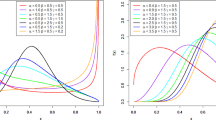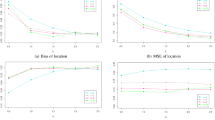Abstract
Burr III (BIII) distribution is used in a wide variety of fields, such as lifetime data analysis, reliability theory, and financial literature, and suchlike. It is defined on the positive axis and has two shape parameters, say c and k. These shape parameters make the distribution quite flexible. They also control the tail behaviour of the distribution. In this study, we extend BIII distribution to the real line and also add a skewness parameter, say \(\varepsilon \), with an epsilon skew extension approach. When the parameters c and k have a relationship such that \(ck \le 1 \), it is skew unimodal. Otherwise, it is skew bimodal with the same level of peaks on the negative and positive sides of the real line. Thus, the epsilon skew extension of Burr III (ESBIII) distribution with only three parameters can provide adequate fits for data sets that may have heavy-tailedness, skewness, unimodality or bimodality. A location-scale form of this distribution is also given. Distributional properties are investigated. The maximum likelihood (ML) estimation method for the parameters of ESBIII is considered. The robustness properties of the ML estimators are studied in terms of the boundedness of the influence function. Further, tail behaviour of ESBIII distribution is also examined to explore the robustness of ESBIII distribution against the outliers. The modelling capacity of this distribution is illustrated using two real data examples.








Similar content being viewed by others
References
Abd-Elfattah AM, Alharbey AH (2012) Bayesian estimation for Burr distribution type III based on trimmed samples. ISRN Appl Math 250393:1–18
Abdulah E, Elsalloukh H (2013) Analyzing skewed data with the epsilon skew gamma distribution. J Stat Appl Prob 2(3):195–202
Acıtaş S, Kasap P, Şenoǧlu B, Arslan O (2013) One-step M-estimators: Jones and Faddy’s skewed t-distribution. J Appl Stat 40(7):1–15
Ali A, Hasnain SA, Ahmad M (2015) Modified Burr III distribution: properties and applications. Pak J Stat 31(6):697–708
Andrade BB, Rathie PN (2016) Fitting asymmetric bimodal data with selected distributions. J Stat Comput Simul 86(16):3205–3224
Arellano-Valle RB, Gomez HW, Quintana FA (2005) Statistical inference for a general class of asymmetric distributions. J Stat Plan Inference 128(2):427–443
Arellano-Valle RB, Cortés MA, Gómez HW (2010) An extension of the epsilon-skew-normal distribution. Commun Stat Theory Methods 39(3):912–922
Arslan O (2009a) Maximum likelihood parameter estimation for the multivariate skew slash distribution. Stat Probab Lett 79(20):2158–2165
Arslan O (2009b) An alternative multivariate skew Laplace distribution: properties and estimation. Stat Pap 51(4):865–887
Arslan O, Genç AI (2009) The skew generalized t distribution as the scale mixture of a skew exponential power distribution and its applications in robust estimation. Statistics 43(5):481–498
Azimi R, Yaghmaei F (2013) Bayesian estimation for the burr type III distribution under type II Doubly censored data. Int J Adv Stat Probab 1(1):1–3
Azzalini A (1985) A class of distributions which includes the normal ones. Scand J Stat 12(2):171–178
Azzalini A, Capitanio A (2003) Distributions generated by perturbation of symmetry with emphasis on a multivariate skew t distribution. J R Stat Soc Ser B 65(2):367–389
Bolfarine H, Martínez-Flórez G, Salinas HS (2013) Bimodal symmetric-asymmetric power-normal families. Commun Stat Theory Methods 47(2):259–276
Box GEP, Tiao GC (1973) Bayesian inference in statistical analysis. Addison-Wesley, Reading
Burnham KP, Anderson DR (2002) Model selection and multimodel inference: a practical information-theoretic approach, 2nd edn. Springer, New York
Burr IW (1942) Cumulative frequency functions. Ann Math Stat 13(2):215–232
Burr IW (1973) Parameters for a general system of distributions to match a grid of \(\alpha _3\) and \(\alpha _4\). Commun Stat Theory Methods 2(1):1–21
Burr IW, Cislak PJ (1968) On a general system of distributions I. Its curve-shape characteristics II. The sample median. J Am Stat Assoc 63(322):627–635
Çankaya MN (2018) Asymmetric bimodal exponential power distribution on the real line. Entropy 20(23):1–19
Çankaya MN, Korbel J (2017) On statistical properties of Jizba–Arimitsu hybrid entropy. Physica A 475:1–10
Çankaya MN, Bulut YM, Doğru FZ, Arslan O (2015) A bimodal extension of the generalized gamma distribution. Rev Colomb Estad 38(2):353–370
Cooray K (2013) Exponentiated sinh Cauchy distribution with applications. Commun Stat Theory Methods 42(21):3838–3852
Dexter OC (2015) Some skew-symmetric distributions which include the bimodal ones. Commun Stat Theory Methods 44(3):554–563
Donatella V, Van Dorp JR (2013) On a bounded bimodal two-sided distribution fitted to the old-Faithful geyser data. J Appl Stat 40(9):1965–1978
Elsalloukh H (2008) The epsilon-skew Laplace distribution. In: The proceedings of the American statistical association, Biometrics Section, Denever Colorado
Elsalloukh H, Guardiola JH, Young M (2005) The epsilon-skew exponential power distribution family. Far East J Theor Stat 17(1):97–107
Embrechts P, Kluppelberg C, Mikosch T (1997) Modelling extremal events for insurance and finance. Springer, Heidelberg
Genç AI (2013) A skew extension of the slash distribution via beta-normal distribution. Stat Pap 54(2):427–442
Genton MG (2004) Skew-elliptical distributions and their applications: a journey beyond normality. Chapman & Hall/CRC, London
Gómez HW, Torres FJ, Bolfarine H (2007) Large-sample inference for the epsilon-skew-t distribution. Commun Stat Theory Methods 36(1):73–81
Gove JH, Ducey MJ, Leak WB, Zhang L (2008) Rotated sigmoid structures in managed uneven-aged northern hardwork stands: a look at the Burr Type III distribution. Foresty 81(2):161–176
Gui W (2014) A generalization of the slashed distribution via alpha skew normal distribution. Stat Methods Appl 23(1):1–17
Hampel FR, Ronchetti EM, Rousseeuw PJ, Stahel WA (1986) Robust statistics: the approach based on influence functions. Wiley, New York
Hao Z, Singh VP (2009) Entropy-based parameter estimation for extended three-parameter Burr III distribution for low-flow frequency analysis. Trans ASABE 52(4):1193–1202
Hassan MY, El-Bassiouni MY (2016) Bimodal skew-symmetric normal distribution. Commun Stat Theory Methods 45(5):1527–1541
Huber PJ (1984) Finite sample breakdown of M- and P-estimators. Ann Stat 12(1):119–126
Jamalizadeh A, Arabpour AR, Balakrishnan N (2011) A generalized skew two-piece skew-normal distribution. Stat Pap 52(2):431–446
Jizba P, Korbel J (2016) On q-non-extensive statistics with non-Tsallisian entropy. Physica A 444:808–827
Jones MC (2009) Kumaraswamy’s distribution: a beta-type distribution with some tractability advantages. Stat Methodol 6:70–81
Jones MC, Faddy MJ (2003) A skew extension of the t-distribution, with applications. J R Stat Soc Ser B 65:159–175
Lindsay SR, Wood GR, Woollons RC (1996) Modelling the diameter distribution of forest stands using the Burr distribution. J Appl Stat 23(6):609–620
Lucas A (1997) Robustness of the student t based M-estimator. Commun Stat Theory Methods 26(5):1165–1182
Markovich N (2007) Nonparametric analysis of univariate heavy-tailed data: research and practice, 2nd edn. Wiley, New York
Mineo AM, Ruggieri M (2005) A software tool for the exponential power distribution: the normalp package. J Stat Softw 12(4):1–24
Mudholkar GS, Hutson AD (2000) The epsilon-skew-normal distribution for analyzing near-normal data. J Stat Plan Inference 83(2):291–309
Prommier Y, Reinhold W, Sunshine M, Varma S (2018) Genomics and bioinformatics group. http://discover.nci.nih.gov. Accessed 10 May 2018
Purdom E, Holmes SP (2005) Error distribution for gene expression data. Stat Appl Genet Mol Biol 4(1):2194–6302
Rathie PN, Silva P, Olinto G (2016) Applications of skew models using generalized logistic distribution. Axioms 5(10):1–26
Rêgo LC, Cintra RJ, Cordeiro GM (2012) On some properties of the beta normal distribution. Commun Stat Theory Methods 41(20):3722–3738
Rényi A (1961) On measures of entropy and information. ISRN Applied Mathematics. Hungarian Academy of Sciences, Budapest Hungary, Budapest
Rodriguez RN (1977) A guide to the Burr type XII distributions. Biometrika 64(1):129–134
Shams HS, Alamatsaz MH (2013) Alpha–Skew–Laplace distribution. Stat Probab Lett 83(3):774–782
Shannon CE (1961) Two-way communication channels. In: Proceedings of the fourth Berkeley symposium on mathematical statistics and probability, volume 1: contributions to the theory of statistics, The Regents of the University of California
Shao Q, Chen YD, Zhang L (2008) An extension of three-parameter Burr III distribution for low-flow frequency analysis. Comput Stat Data Anal 52(3):1304–1314
Subbotin MT (1923) On the law of frequency of errors. Mat Sb 31:296–301
Swamee PK, Rathie PN (2007) Invertible alternatives to normal and lognormal distributions. J Hydrol Eng 12(2):218–221
Tadikamalla PR (1980) A look at the Burr and related distributions. Int Stat Rev 48(3):337–344
Venegas O, Hugo SS, Gallardo DI, Bolfarine H, Gómez HW (2017) Bimodality based on the generalized skew-normal distribution. J Stat Comput Simul 88(1):156–181
Wang FK, Keats JB, Zimmer WJ (1996) Maximum likelihood estimation of the Burr XII parameters with censored and uncensored data. Microelectron Reliab 36(3):359–362
Wingo DR (1983a) Maximum Likelihood Methods for fitting the Burr type XII distribution of life test data. Bio Met J 25(1):77–84
Wingo DR (1983b) Estimating the location of the Cauchy distribution by numerical global optimization. Commun Stat-Simul C 12(2):201–212
Zimmer WJ, Keats JB, Wang FK (1998) The Burr XII distribution in reliability analysis. J Qual Technol 30(4):386–394
Zoraghi N, Abbasi B, Niaki STA, Abdi M (2012) Estimating the four parameters of the Burr III distribution using a hybrid method of variable neighborhood search and iterated local search algorithms. Appl Math Comput 218(19):9664–9675
Acknowledgements
We thank the anonymous reviewers for their careful reading of our manuscript and their many insightful comments and suggestions. We would like to say our special thanks to the Editorial Board Members. We thank the native speaker who supported us for representation in the formal organization of this paper.
Author information
Authors and Affiliations
Corresponding author
Additional information
Publisher's Note
Springer Nature remains neutral with regard to jurisdictional claims in published maps and institutional affiliations.
Appendix
Appendix
Proof of Theorem 2.4
where
Now consider the integral \(\int _{\mu }^{\infty } f_{+}^{\alpha }(x)dx\). This integral is analytically obtained by applying the transformations, \(y=\frac{x-\mu }{\sigma (1+\varepsilon )}\), \(u=y^{-c}\), \(v=1+u\) and \(z=1/v\), consecutively. These steps are given as follows.
where \(\alpha (k-1/c)+1/c>0\), \(\alpha (1+1/c)-1/c>0\). Similarly, the other integral is obtained as
where \(\alpha (k-1/c)+1/c>0\), \(\alpha (1+1/c)-1/c>0\).
Then, the Rényi entropy is
where \(\alpha (k-1/c)+1/c>0\), \(\alpha (1+1/c)-1/c>0\), \(\alpha >0\) and \(\alpha \ne 1\).
The Shannon entropy is obtained by finding \(\underset{\alpha \rightarrow 1}{\lim } J_{\mathbb {R}}(\alpha )\). One can apply L’Hôpital rule to find this limit. Thus,
which is the Shannon entropy. Here \(B(\cdot )\) is beta function, \(\psi (\cdot )\) is digamma function and \(\gamma \) is Euler constant. \(\square \)
Rights and permissions
About this article
Cite this article
Çankaya, M.N., Yalçınkaya, A., Altındaǧ, Ö. et al. On the robustness of an epsilon skew extension for Burr III distribution on the real line. Comput Stat 34, 1247–1273 (2019). https://doi.org/10.1007/s00180-018-0859-y
Received:
Accepted:
Published:
Issue Date:
DOI: https://doi.org/10.1007/s00180-018-0859-y




